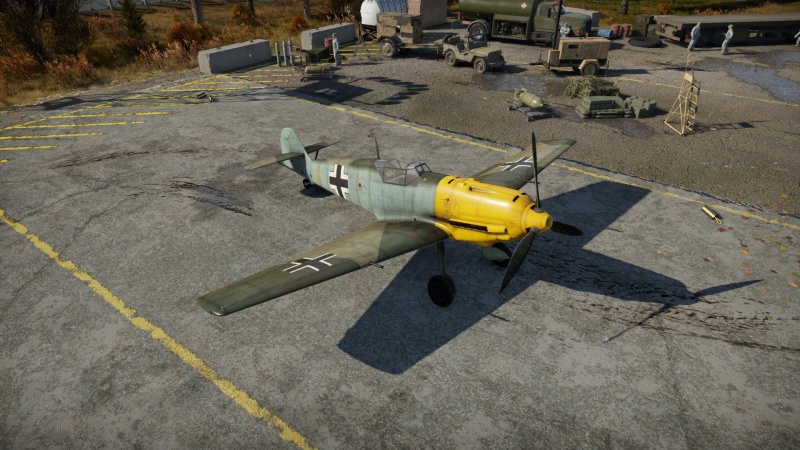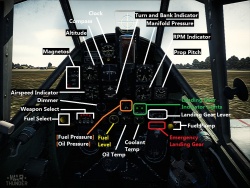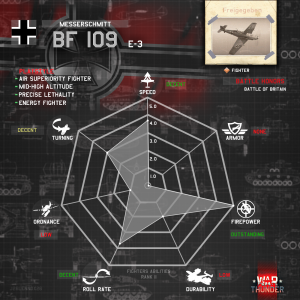Bf 109 E-3
| This page is about the German fighter Bf 109 E-3. For other versions, see Bf 109 (Family). |
Contents
Description
The Bf 109 E-3 is a rank II German fighter with a battle rating of 2.7 (AB/SB) and 2.3 (RB). It has been in the game since the start of the Open Beta Test prior to Update 1.27.
After having experienced the Bf 109 E-1, players will rejoice upon unlocking the E-3. While essentially the same plane, the E-3 overcomes the inadequate firepower (compared to other aircraft of similar BR) of the E-1. With two wing-mounted 20 mm MG FF cannons, the plane packs a deadly punch. Players that did well in the E-1 and learned their Bf 109 trade will be able to make great use of their new Emil. Fighting in the E-3 is essentially the same in the E-1 with the difference that a pilot can now actually reliably dispatch enemies in a short burst.
Remaining a great energy fighter against its historical opposition, the E-3 is somewhat troubled by the fact that it often faces mid-to-late-war planes such as the P-47D. To engage these, make sure to have a clear energy advantage: if attacked, fly defensively and attempt to bleed the enemy's speed while pulling them down. The Bf 109 E-3 is often regarded as a poor turner, a reputation coming out of the fact that its main rival, the Spitfire, simply did it better. However, with combat flaps, the E-3 is a respectable turner able to out-manoeuvre most planes that outperform it in firepower or other factors.
The 20 mm MG FF cannons can not fire Minengeschoss shells. These shells have thin cases, allowing more incendiary material to be used. however, these very same characteristics prevent these shells from being fired from older MG FF versions like the E-3 sports. This means that the E-3's cannons compare poorly with the later MG FF/Ms.
General info
Flight performance
| Characteristics | Max Speed (km/h at 5,000 m) |
Max altitude (metres) |
Turn time (seconds) |
Rate of climb (metres/second) |
Take-off run (metres) | |||
|---|---|---|---|---|---|---|---|---|
| AB | RB | AB | RB | AB | RB | |||
| Stock | 544 | 536 | 11000 | 20.9 | 21.8 | 14.7 | 14.7 | 376 |
| Upgraded | 591 | 570 | 19.1 | 20.0 | 21.6 | 17.8 | ||
Details
| Features | ||||
|---|---|---|---|---|
| Combat flaps | Take-off flaps | Landing flaps | Air brakes | Arrestor gear |
| ✓ | ✓ | ✓ | X | X |
| Limits | ||||||
|---|---|---|---|---|---|---|
| Wings (km/h) | Gear (km/h) | Flaps (km/h) | Max Static G | |||
| Combat | Take-off | Landing | + | - | ||
| 790 | 320 | 477 | 448 | 300 | ~12 | ~5 |
| Optimal velocities (km/h) | |||
|---|---|---|---|
| Ailerons | Rudder | Elevators | Radiator |
| < 450 | < 390 | < 400 | > 312 |
| Compressor (RB/SB) | ||
|---|---|---|
| Setting 1 | ||
| Optimal altitude | 100% Engine power | WEP Engine power |
| 4,800 m | 905 hp | 1,086 hp |
Survivability and armour
- No armour plating
- No armour glazing
- Self-sealing fuel tanks (1 under pilot)
- Critical components located in front of aircraft (fuel, pilot, engine, controls, cooling)
Modifications and economy
Armaments
Offensive armament
The Bf 109 E-3 is armed with:
- 2 x 20 mm MG FF cannons, wing-mounted (60 rpg = 120 total)
- 2 x 7.92 mm MG 17 machine guns, nose-mounted (1,000 rpg = 2,000 total)
Suspended armament
The Bf 109 E-3 can be outfitted with the following ordnance:
- Without load
- 4 x 50 kg SC50JA bombs (200 kg total)
- 1 x 250 kg SC250JA bomb (250 kg total)
Usage in battles
Just as the with the E-1, new players should adopt a hit-and-run tactic with the Bf 109s (also known as Boom-and-Run). While often called a Boom & Zoom aircraft, the Bf 109s are not dedicated Boom & Zoomers, and many other aircraft such as the Fw 190 do it much better. While it is true that a pure Boom and Zooming approach can be used for the Bf 109s, limiting oneself to this enormously undermines the plane's efficiency. That said, the Bf 109s do build up speed quickly in a dive, and they have a respectable zoom climb that ends in a strongly sustained climb at ~270 km/h (optimal climbing speed 260, and dash 280 km/h). Doing so will often give the player the maximum speed or altitude advantage they can have over their chosen target. A straight-up bounce, with a short extend from the target and a slowly increasing climb leading into an Immelmann, tends to work best for rookie pilots. Remember to check your six and surroundings during the climb and just before diving back onto the target. Don't forget to try and gain altitude but only up to 3,000 m is recommended but 4,000 m is the limit as anything higher will cause you controls to stiffen and "buckle out" meaning turn rate will get considerably slow and bombers at that altitude will be able to easily outrun you.
With mounting experience on the side of the player, the energy fighting abilities of the Bf 109 E-3 come to the forefront. Fluid and speedy transitions between altitude and speed, together with well-timed uses of flaps, throttle, and manoeuvres, enable the Emil to quickly change engagement in its favour.
When firing at enemies, be aware that the 20 mm cannons only hold a 60-round drum magazine each. They empty quick, and many a new pilot has seen themselves on pitifully low ammunition after only one attack run. Once the cannons are empty, the E-3 will be hard-pressed to destroy any aircraft. Do not waste the cannon ammunition on ground targets and when firing at planes, fire in short, controlled, and well-aimed bursts. Luckily, the E-3 holds 1,000 rounds in each of its two MG 17s. Use these if inclined to spray and pray or are about to engage ground targets.
The E-3 can load either 4 x 50 kg or 1 x 250 kg either. Unless wanting to fly at a severe disadvantage, do not use the bombs unless it is necessary to win a match, for example after refuelling/restocking at the base. The bomb load is nowhere near large enough to make a fighter bombing trip worth it.
Simulator Battles
In Simulator, the Bf 109 E-3 is quite a friendly fighter that can perform many tasks. It offers great flight performance with its smooth handling, adequate speed, and impressive climb rate and turn rate. The nose gently slopes down from the windscreen, offering great over-the-nose vision. Despite having a razorback, the Emils actually have great visibility towards the tail, increasing the pilot's situational awareness. There are also a few bomb options to choose from which are beneficial for ground-pounding or base-bombing, although these are not its primary objectives. However, the E models have their cannons mounted on the wings which is not very friendly to aim, and each cannon only has a poor 60-round drum as mentioned above.
You can bring the least fuel amount, since the 60-round drums run out fast, making you constantly return to base to rearm so there is no point bringing more fuel. A close gun convergence set at around 250-400 m is recommended, given the low velocity of the cannons. You can also set keys for vertical head movement, as lifting up your head a little helps improving the over-the-nose visibility.
Dogfighting in SB involves everyday RB tactics. Utilise common manoeuvres such as Immelmann, Split-S, scissor, barrel roll, etc. You may want to practice smoothing the aircraft, as the wing guns are quite awkward to aim. To make every shell count, get close and "let the enemy fill up your windscreen". A good distance to open fire is when their wingtips fully fill up the reticule circle. Note: the Bf 109 handles very sluggishly in the roll axis at low speed, so take this into account if dogfighting at low speed/altitude. You can even pull the elevator fully for maximum agility, but only if you pull gently and gradually will the 109 manoeuvre as you wish. If maximum elevator input is harsh and sudden, the plane will start swaying around and enter a flat spin. The aircraft can quite easily recover from a flat spin by fully deflecting elevators downward and rudder to the opposite side of which the plane is spinning, and wait until it starts a dive and gather some speed to pull up.
Landing may need practice for some. It is easy at first: decelerate and descent towards the runway, deploy combat, takeoff, landing flaps and gears in order, fly at ~190 km/h before touchdown. If the plane bounces up with landing flaps, use takeoff/combat flaps instead to reduce lift. Note that you must align the plane with the airstrip correctly prior to touchdown and do not yaw/break one side too much when breaking, as the main landing gears are so close together that they cannot support such sideways force, causing the plane to wobble dangerously or even tilt towards one side, striking a wingtip into the ground.
Manual Engine Control
| MEC elements | ||||||
|---|---|---|---|---|---|---|
| Mixer | Pitch | Radiator | Supercharger | Turbocharger | ||
| Oil | Water | Type | ||||
| Not controllable | Controllable Not auto controlled |
Controllable Not auto controlled |
Controllable Not auto controlled |
Separate | Not controllable 1 gear |
Not controllable |
Pros and cons
Pros:
- Good acceleration
- Good rate of climb
- Good continuous turn rate
- Good roll rate
- Good sustained turn rate
- Plenty of LMG ammo
- Can perform negative G manoeuvres
- Better cockpit visibility than Bf 109Fs
Cons:
- Less than average instantaneous turn rate
- Control stiffening above 400 km/h (IAS)
- Low cannon ammo
- Weak low-velocity cannons compared to Hispano, MG 151, etc
- Relatively poor durability
History
The Bf 109 E-3 became the mainstream fighter of the German Luftwaffe between 1940 to 1941. Seeing some action in 1939, the E-3 was the most produced aircraft of the Emil series and much appreciated by pilots. While pilot comfort was not what one might call outstanding, German pilots held the Emil in high regard, due to its performance and offensive bite. Its improvements over the Bf 109 E-1 were a strengthening of the structural integrity and the integration of two-wing mounted MG FFs in the wings, replacing two MG 17s the earlier Emil carried. In order to save the 20 mm shell cases, the wing had a small empty container in which used casings were thrown into after firing of the weapon.
Powered by a DB 601 Aa with a performance of 1175 hp upon takeoff, the plane was initially regarded as a technological secret. This was due to the use of a direct petrol injection system that allowed the engine to run when experiencing negative Gs. The frequent use of a Split-S to evade earlier Spitfire and Hurricanes using carburettor engines shows the distinct advantage such a system gave. While it worked as a trump card for some time, the nature of war ensured that Allied forces soon had access to downed Bf 109 E-3s and their engine configuration. The first Bf 109 E-3 to fall into enemy hands happened as early as November 1939 near Woerth, France.
The E-3 was one of the first planes that saw widespread exportation. Bulgaria, Japan, Switzerland, and Spain are some of the countries that purchased the Emil.
The E-3 was used extensively in the Battle of Britain, eventually being replaced by the Friedrich.
| Archive of the in-game description | |
|---|---|
|
The Messerschmitt Bf 109 was a single-seat monoplane fighter used by the Luftwaffe before and during WWII. It was used as a fighter, interceptor, high-altitude interceptor, fighter-bomber and reconnaissance aircraft. The Bf 109 E variant, or "Emil", was in fact the first truly mass-produced variant of the venerable Messerschmitt Bf 109 family. Powered by a new Daimler-Benz DB 601A direct fuel injection engine, the Emil also had a redesigned supercharger. However, most importantly, the engine proved much more reliable than its predecessors. First production variants reached front-line units in early 1939. The Emil was armed with two 7.9mm machine guns in the engine housing and two 20mm cannon in the wings. | |
Media
- Skins
- Videos
See also
- Aircraft of comparable role, configuration and era
External links
- Official data sheet - more details about the performance
- Radinger, Willy & Otto, Wolfgang, Messerschmitt Me 109 - Das meistgebaute Jagdflugzeug der Welt - Entwicklung, Erprobung, Technik - Bf 109A bis 109K, Aviatic Verlag, Oberhachingen: 2011
- "Falcon's Messerschmitt Bf 109 Hangar" Bf 109E subpage
- [Wikipedia] Messerschmitt Bf 109 variants – Bf 109 E
- "Performance Information Bf 109E"
| Germany fighters | |
|---|---|
| Heinkel | |
| He 51 | He 51 A-1 · He 51 B-1 · He 51 B-2/H · He 51 C-1 · He 51 C-1/L |
| He 100 | He 100 D-1 |
| He 112 | He 112 A-0 · He 112 B-0 · He 112 B-1/U2 · He 112 B-2/U2 · He 112 V-5 |
| Messerschmitt | |
| Bf 109 (Jumo) | Flegel's Bf 109 A · Bf 109 B-1 · Bf 109 C-1 · Bf 109 C-1 |
| Bf 109 (DB-601) | Bf 109 E-1 · Bf 109 E-3 · Bf 109 E-4 · Bf 109 E-7/U2 · Bf 109 F-1 · Bf 109 F-2 · Bf 109 F-4 · Bf 109 F-4/trop |
| Bf 109 (DB-605) | Bf 109 G-2/trop · Bf 109 G-2 · Bf 109 G-6 · Bf 109 G-10 · Bf 109 G-14 · Bf 109 K-4 |
| Focke-Wulf | |
| Fw 190 (early) | Fw 190 A-1 · Fw 190 A-4 · Fw 190 A-5 · Fw 190 A-5 · Fw 190 A-5/U2 · Fw 190 A-5/U14 · Fw 190 A-8 · Fw 190 C |
| Fw 190 (late) | Fw 190 D-9 · Fw 190 D-12 · Fw 190 D-13 |
| Ta 152 | Ta 152 C-3 · Ta 152 H-1 |
| Blohm & Voss | |
| BV 155 | BV 155 B-1 |
| Captured: | |
| USA | ▀P-47D-16-RE · ▀P-47D |
| USSR | ▀La-5FN · ▀Yak-1B |
| Britain | ▀Tempest Mk V |
| Italy | |
| CR.42 | ▀CR.42 · ▀Marcolin's C.R.42 CN |
| G.50 | ▀G.50 serie 2 · ▀G.50 AS serie 7 |
| C.200 | ▀C. 200 serie 3 · ▀C. 200 serie 7 |
| C.202 | ▀C. 202 |
| Finland | ▀Hawk H-75A-2 |







